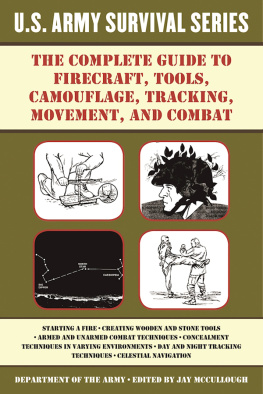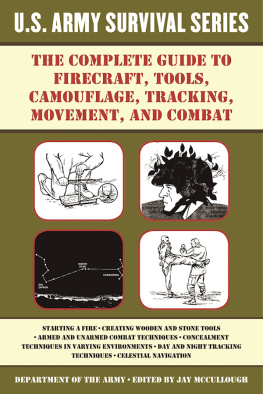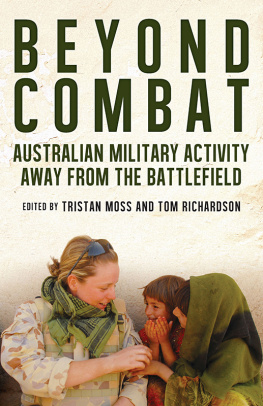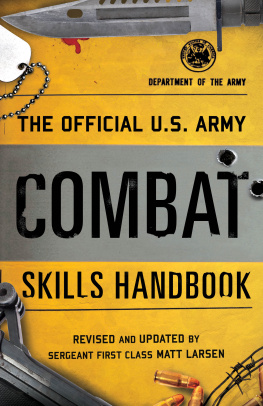COMBAT
TRACKING
GUIDE

COMBAT
TRACKING
GUIDE
John Hurth
STACKPOLE
BOOKS
Copyright 2012 by Stackpole Books
Published by
STACKPOLE BOOKS
5067 Ritter Road
Mechanicsburg, PA 17055
www.stackpolebooks.com
All rights reserved, including the right to reproduce this book or portions thereof in any form or by any means, electronic or mechanical, including photocopying, recording, or by any information storage and retrieval system, without permission in writing from the publisher. All inquiries should be addressed to Stackpole Books, 5067 Ritter Road, Mechanicsburg PA 17055.
Printed in the United States of America
10 9 8 7 6 5 4 3 2 1
First edition
Library of Congress Cataloging-in-Publication Data
Hurth, John.
Combat tracking guide / John Hurth. 1st ed.
p. cm.
Includes index.
ISBN 978-0-8117-1099-2
1. Scouting (Reconnaissance) 2. Tracking and trailing. I. Title.
U220.H87 2012
355.4'13dc23
2012005460
eISBN: 9780811748612
This book is dedicated to all combat trackers,
past and present, as well as the men and women in uniform
who have served and continue to serve our great nation.
Contents
Troops in Contact
Certainly there is no hunting like the hunting of man and those who have hunted armed men long enough and liked it, never really care for anything else thereafter. Ernest Hemingway
Somewhere in the current theater of operations a small convoy of military vehicles winds its way down a narrow, unimproved road. The surrounding terrain is steep and rugged, and channelizes traffic. On the south side, the road butts up to a mountain, and from the north edge of the road, the terrain drops down into a cultivated area that eventually runs into an intermittent stream. On the north side of the stream the terrain gradually rises above the valley floor.
Approximately two hundred meters north of the stream, an enemy force is watching. Patiently, they wait for the lead vehicle to reach a culvert below the road surface. The culvert marks and conceals the location of an improvised explosive device (IED). As the lead vehicle in the convoy creeps over the culvert, the enemy initiates the ambush with the IED. There is a violent explosion and the vehicle is engulfed by a plume of smoke and dust. The force of the blast picks up the vehicles front end and slams it back down to earth. The lead vehicle comes to an abrupt stop. As the smoke and dust begin to settle, the rear door on the passenger side opens and a soldier falls out. In shock and confusion, he tries to crawl to safety. The convoy stops behind the lead vehicle, which is now blocking the narrow road.
Immediately, the enemy opens fire from an elevated position across the stream with rocket-propelled grenades (RPGs) and small arms. Stunned by the sight of the lead vehicles destruction, the soldiers scramble to reorient their weapons on the enemy and return fire. The chaos of battle ensues. The infantry platoon leader radios troops in contact! to the company tactical operations center. After assessing the enemy situation, the platoon leader requests assistance from the quick reaction force (QRF), along with immediate close air support.
The battle between the platoon and the ambushers carries on for almost thirty minutes. Just as abruptly as the fight began, however, it seems to end. The explosions of RPGs cease and the chatter of small-arms fire fades, and it appears to the soldiers on the ground that the enemy is breaking contact and retrograding from its fighting position.
Instantly, the platoon leader starts receiving ACE (ammo, casualties, and equipment) reports from his squad leaders, who inform him of four friendlies killed in action, three friendlies wounded, and one friendly vehicle destroyed. The squad leaders issue orders to their team leaders, who begin consolidating, reorganizing, and adjusting their perimeter. The platoon sergeant designates the casualty collection point while the platoon medic and combat life-savers feverishly attempt to save the lives of their wounded comrades. Minutes later, two A-10 Thunderbolts arrive on station and loiter overhead. The platoon leader has his joint terminal attack controller check in and coordinate with the aircraft to strafe the enemys last known position.
The aircraft bank away and conduct a gun run, peppering the side of the mountain with 30 mm cannon fire. The aircraft pull up and off the target and continue to loiter overhead to give the platoon cover and time to prepare the convoy for movement out of the kill zone.
The platoon leader requests a medical evacuation and is told that it will take approximately forty minutes to arrive. The remaining soldiersnow low on ammoquickly strip the destroyed vehicle of all remaining munitions and sensitive items. When they are done, they push it off the road. A squad leader moves down to the vehicle and throws two incendiary grenades into the vehicle to ensure it is totally destroyed before abandoning it.
The platoon begins cross-loading the remaining vehicles with the dead and wounded soldiers. Once theyre finished, the platoon leader and platoon sergeant receive an up from the squad leaders that everyone is ready to move. The convoy slowly limps its way east two kilometers to a suitable helicopter landing zone to link up with the QRF and evacuate their dead and wounded.
One of the many difficulties military units face when conducting operations is locating and maintaining contact with a light, mobile, and elusive enemy. Too often the above scenario is the norm rather than the exceptiona small enemy force strikes, contact ensues then breaks, and the attackers drift away without pursuit.
There is a military tactic that when properly employed will radically alter the scenario described and could thereby greatly change the outcome of the conflicts our forces fight. It is the use of visual tracking techniques the efficient and aggressive pursuit of a foot-borne enemy by trained members of a combat tracking unit.
Unfortunately, visual tracking is perhaps the single most misunderstood, underused, and underestimated combat capability. Most of these erroneous opinions about visual tracking are based on misconceptions and misrepresentations that come from the tracking community. Trackers who teach holistic forms of tracking that focus their instruction on a spiritual aspect, or who teach programs that are technically and tactically unsound, have crushed any true debate on the virtues of tracking as a military specialty skill.
What most people do not understand is that it is virtually impossible for even a single person to move across any terrain for any distance without leaving some type of evidence of his passage. If one looks at sign left by the quarry and puts it into the context of military intelligence, then the physical evidence becomes intelligence indicators. And indicators observed by a trained tracker will provide immediate, valuable intelligence about the enemy: size of force, direction and rate of movement, infiltration and exfiltration routes as well as methods used, safe areas used, size of load and type of weapon being carried, age and sex, physical disabilities, state of training and discipline, and capabilities and intentions.
In an environment where information about an enemy is limited, the primary means of intelligence gathering will be through conducting dismounted patrols. The conduct of combat tracking operations closely mirrors the F3EAD targeting methodology:
Next page









